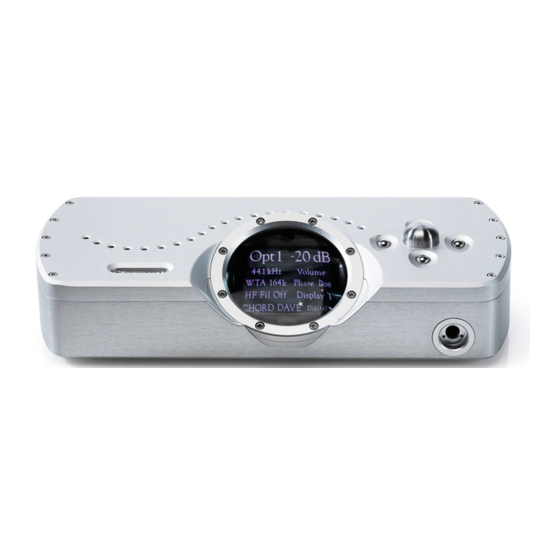Advertisement
Table of Contents
- 1 Mains Connection Instructions
- 2 Cleaning and Care Instructions
- 3 Audio Outputs
- 4 Digital Inputs
- 5 Manual Controls
- 6 Remote Control
- 7 Setup Options
- 8 DAC Mode
- 9 Headphone Mode
- 10 Driver Installation
- 11 Configuring Mac os
- 12 De-Emphasis Coding
- 13 Display Blanking
- 14 Product Specification
- Download this manual
Advertisement
Table of Contents

Summary of Contents for Chord DAVE
- Page 1 Chord Electronics Limited DAVE DIGITAL / ANALOGUE CONVERTER OPERATING INSTRUCTIONS - ! -...
- Page 2 Chord Dave connection diagram - ! -...
-
Page 3: Mains Connection Instructions
Never spray directly onto the converter and never use abrasive cleaning, use only a lint free soft cloth. There are no user serviceable parts in Dave. It should be serviced only by Chord Electronics Limited or their expressly approved service agents. -
Page 4: Audio Outputs
RCA phono style connectors. Each of these will drive down to a 50ohm load. This means that Dave will work with all known pre-amplifiers and is able to drive very long audio cables without difficulty. Both audio outputs work at the same time so this allows Dave to be connected to two pre-amplifiers if needed. - Page 5 The middle section of the screen shows the setup options which can be accessed using the menu mode. You have 4 menu options for PCM/DSD mode, Phase, HF filter, and Display mode. The bottom part of the screen indicates Digital Preamplifier mode, DAC mode, or Headphone mode. In display mode 2 you only have black and white theme where the sample rate and volume colours are not shown.
-
Page 6: Manual Controls
Manual Controls Dave can be operated manually by the controls on the top of the unit, or it can be operated using the supplied remote control. Using these controls you can select the digital input, adjust the volume level, and make changes to the setup options. -
Page 7: Remote Control
Remote Control Dave is supplied with a full system remote control that will work for all Chord products, televisions, and DVD players. Full instructions can be found in the System Remote Manual supplied, but for the purposes of controlling Dave the main functions are listed on the next page. - Page 8 Adjusting the volume Press the Vol+ button on the centre control to increase the volume, press the Vol- button on the centre control to decrease the volume. Mute Press the key to mute Dave. To un-mute Press the key again. Standby: Press the button.
-
Page 9: Setup Options
DSD+ or PCM+ Mode – Toggle between the two modes. Dual Data Mode - Dave supports dual data mode on its BNC inputs. This is where a 176kHz data rate is supported by sending a left 88kHz signal and a right 88kHz signal via separate BNCs. For example this function is supported with our Blu CD Transport. -
Page 10: Dac Mode
DAC Mode Dave can be used with the inbuilt volume control to drive an amplifier directly but should you wish to use it with a preamplifier or AV amplifier it can be switched to DAC Mode. Simultaneously pressing both left and right buttons on the top panel will activate DAC mode and this will be indicated on the bottom right of the display. -
Page 11: Driver Installation
Installing the driver on a Mac, Android or Linux device Dave uses a class compliant USB interface so it does not require any driver software on Mac, Android or Linux devices. Simply plug a USB2.0 USB cable between Dave and the computer, tablet or phone and it will be automatically detected and play. -
Page 12: Configuring Mac Os
Display Blanking In order for Dave to write the settings to memory such as volume or one of the menu settings the display will blank for approximately 1 second. This is completely normal and allows all the... -
Page 13: Product Specification
Product Specification FREQUENCY RESPONSE: 20Hz to 20kHz flat within +/-0.1dB (HF filter off) THD + N: 127.5dB (AWT) CHANNEL SEPARATION: >125dB @ 1KHz DYNAMIC RANGE: 127.5dB (AWT) DIGITAL INPUTS: 4 x 75Ω SP/DIF BNC Coax 44.1KHz - 384KHz 1 x AES Balanced XLR 44.1KHz - 96KHz 2 x Plastic fibre optic ( TOSlink ) 44KHz - 192KHz 1 x USB ( B type ) 44KHz - 768KHz PCM + DSD ANALOGUE OUTPUTS:...
















Need help?
Do you have a question about the DAVE and is the answer not in the manual?
Questions and answers